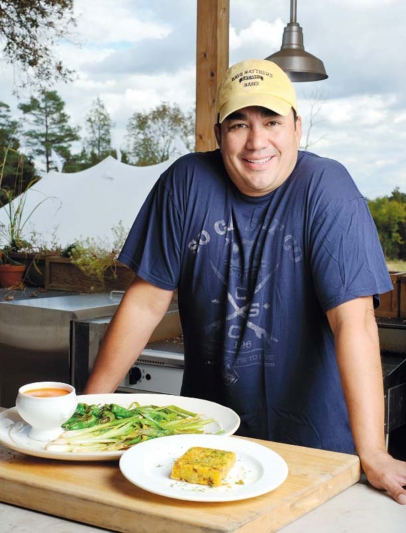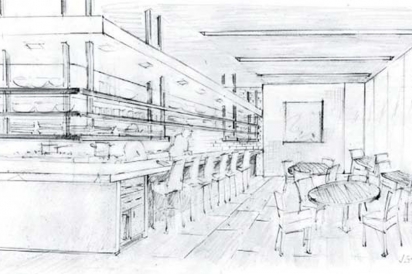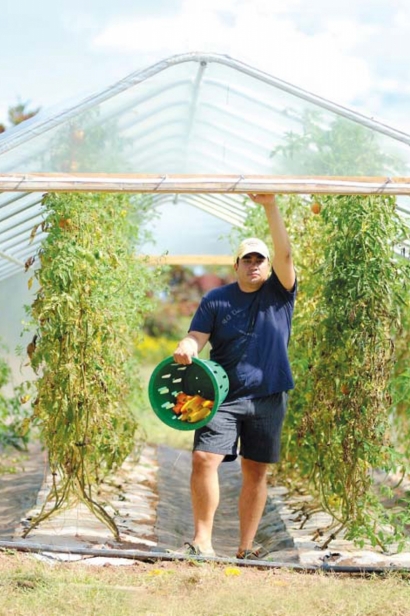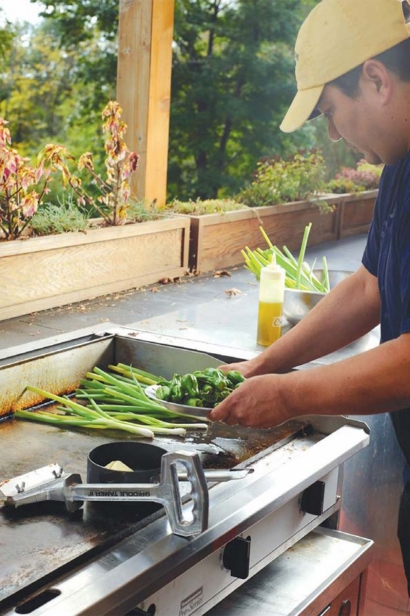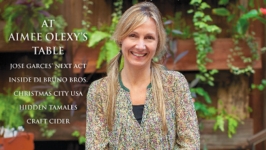Cooking Fresh: Field of Dreams Leads to Restaurant Volver
On a recent trip to Japan, Jose Garces ate the best mango he’s ever tasted in his life. It should have been a superlative specimen—it cost the Iron Chef $300. The price tag was worth it, according to him, not just for the tangy sweetness of the world’s most perfect piece of fruit but for the insight it gave him about ingredients.
“To get this mango, they prune the tree, trim it back so that a whole tree yields just one mango,” says Garces. The totality of that particular tree’s resources—all the sunlight, water and intense careful tending—are poured into a single piece of fruit. “It shows an obsession with the quality of ingredients, and it’s one of the most important things for any chef to understand.” This is a lesson he’s been keeping top of mind as he prepares to open his most ambitious restaurant so far, Volver, in Center City’s glitzy Kimmel Center. It’s tentatively scheduled for a December unveiling. Volver will encompass a Champagne bar, a 30-seat room that sounds fit for Robin Leach with its focus on sparkling wine, caviar and other elegant bites, and the dining room, where guests will have a gustatory romp through Garces’s boldest and brightest ideas over an elaborate 12-course tasting menu. And unlike at his other restaurants, he will actually, regularly be cooking at Volver, he says.
It’s his culinary research for this project that has taken him to mango farms in Japan and a string of the best and most creative restaurants around the world, including the experimental Etxebarri in Spain and the most lavishly ballyhooed restaurants in the U.S., including New York’s Per Se and Chicago’s Alinea. Garces talks about a recent meal at Manresa, an ultra-fine dining restaurant in Northern California famous for its inventive and outstanding food, in reverent tones, as he describes a particularly memorable dessert of smoked milk ice cream.
“I’ve been a careful student of those experiences. My whole culinary team has been as well,” he says. When I ask him if we can expect Volver to be on par with the restaurants he describes as his inspirations he says, in a guarded, measured way, “Volver will be an unparalleled dining experience.” No one wants to set the bar impossibly, stratospherically high. But there’s little doubt he hopes to join the ranks of Grant Achatz and Thomas Keller, guys widely acknowledged to be among planet Earth’s most brilliant chefs. It seems clear he wants Volver to be one of the best restaurants in the world. In the parlance of that TV show that has made him quite famous, what will be Garces’ “secret ingredient” in his battle for supremacy?
There are no single-fruit mango trees at Luna Farms, Garces’ eight-acre organic operation that keeps his cadre of restaurants in microgreens, eggs, herbs and heirloom tomatoes, but the spirit of that encounter is in the air in his fields there. The goal at Luna is peerless produce. A recent plate of Luna-grown shisitos, fried and served as a small plate at Garces’ flagship Amada, is a good example of how the farm helps keep his many menus feeling fresh. The peppers were anything but mass produced—they were not uniform in size or even taste (some searingly hot, others totally mild)—but they were full flavored and vivid in a way only just-harvested vegetables can be.
Notably, the dish’s menu description doesn’t mention the peppers’ provenance. In fact, nowhere will you find Amada described as a farm-to-table restaurant. Of course, with its Spanish influence, a great many of the items are imported from around the U.S. and indeed the globe. “I want the ingredients that taste best and are the most right for my menus,” says Garces. That’s just as likely to include pricy imported cured meats, such as jamón Ibérico, as it is to be those piquant peppers. Garces believes in using and celebrating the region’s local food without being held hostage by the “farm-to-table” identity that has defined, often wrongly, a welter of middling eateries in recent years. “I think we should stop talking about it.”
It is a tough topic to avoid, though, thanks to its dominance on myriad menus. The words spring meaningless off so many chef ’s tongues. The explanation may be simple economics. “At a certain point in 2008, fine dining just kind of went away,” says Garces. At the time, upstart chefs in Philly and around the country created restaurants that served home-style food based on the best-tasting ingredients they could afford: local ones. Seasonality ruled, and the food was both approachable and affordable. As a concept, it can work. As a buzzword? Not anymore.
But even if we won’t mention it again, local food informs Garces’ style. “It’s actually my favorite way to cook at home, especially when we’re at the farm and I bring produce that’s still warm from the sun right into my kitchen.” With food that fresh, you don’t have to do much to the ingredients, according to Garces. But away from his home stove, in his restaurants, he wants to do more than let pretty carrots speak for themselves. At Volver, he wants to do a lot more. If Garces has his way, Volver will revive fine dining in Philadelphia in a way that so far no one else has been able to do.
None of this means that Volver’s food will be too high concept for the region’s best local ingredients. In fact, select items will be harvested at Luna Farms. Garces plans to plant some unusual, hardto- find produce specifically for this menu. Foraged wild foods from around the Luna Farms property may also make appearances. “We talked about maybe harvesting purslane and chickweed,” says Luna Farms manager, Jillian Herschlag, though she stresses that nothing is set in stone, and it’s too early to say exactly what role the farm’s crops will have in the Volver kitchen. It seems obvious, though, that whenever eggplant, peppers, sweet heirloom tomatoes or anything else that’s routinely grown on the farm is needed at Volver, Garces will harvest them from his farm.
What Garces gets from the fields at Luna goes beyond the obvious vegetables and eggs. There’s inspiration and creative renewal for him germinating in the organic soil, as well. “Coming in contact with ingredients where they grow, pulling them from the roots with your hands…it makes me want to cook,” he says. Herschlag says his passion for the farm shows in the chef ’s face, in the energy he exudes, as when he bounds out to the field upon arrival at the farm to see what is going on there and to harvest the food. “He really wants diners to feel connected to the food, too,” she says.
When he began shopping for property for his family’s country house, a place to serve as a retreat from his hectic schedule and city life, a farm wasn’t part of the plan. But when he found Luna, with its ample acreage, his mind wandered back to an earlier time in his life, before he opened Amada, when he couldn’t know his one restaurant would swiftly lead to 14 more and that he would become the city’s biggest celebrity chef, his face a regular sight on TV. Back then, he was living in Delaware County where he built a few raised beds and planted peppers, tomatoes and herbs. “That was where I got my green thumb and the beginning of this whole process of growing my own food,” he says. It changed the way he thought about being a chef.
Even when Luna’s fields proved difficult to farm due to the high percentage of clay in the soil and underground springs that make the land wet and swampy, Garces wasn’t deterred. “You can’t even take a tractor onto the fields because it compacts the soil and makes the problems worse,” says Herschlag. In cooperation with the USDA, Luna Farms is in the middle of a costly, labor-intensive project to improve drainage in the fields there. Garces believes it’s worth doing because it is good for the environment and allows the farm to grow. With these improvements, he hopes to increase the farm’s yield to the point that its small private CSA, now for friends and employees only, can be made open to the public.
You can see the fields from the windows of his house there, the family retreat that is Luna’s original reason for being. It’s the kind of home that’s impressive enough to be featured in design magazines, but it’s not ostentatious. It’s easy to imagine his family and friends hanging out in the spacious, comfortable rooms, to envision Garces in the well-equipped kitchen slicing orange tomatoes and glossy black eggplants. He says that’s exactly where you’ll find him on many weekends and during Thanksgiving and Christmas—those times that he most needs to replenish his energy and incubate ideas.
With Volver’s opening so close at hand, it may be harder than usual for him to carve out the time to spend at Luna Farms, but as his most creative project gets closer to opening its doors, it’s also more important than ever. These fields may empower our own soft-spoken Iron Chef to give Philadelphia the kind of world-class culinary palace it deserves.


